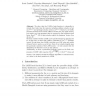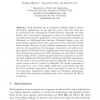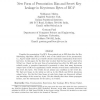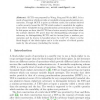FSE
2008
Springer
15 years 2 months ago
2008
Springer
We show that the LASH-x hash function is vulnerable to attacks that trade time for memory, including collision attacks as fast as 2(4x/11) and preimage attacks as fast as 2(4x/7) ....
105
click to vote
FSE
2008
Springer
15 years 2 months ago
2008
Springer
At Crypto 2007, Joux and Peyrin showed that the boomerang attack, a classical tool in block cipher cryptanalysis, can also be very useful when analyzing hash functions. They applie...
116
click to vote
FSE
2008
Springer
15 years 2 months ago
2008
Springer
Hash functions are an important building block in almost all security applications. In the past few years, there have been major advances in the cryptanalysis of hash functions, es...
FSE
2008
Springer
15 years 2 months ago
2008
Springer
Consider the permutation S in RC4. Roos pointed out in 1995 that after the Key Scheduling Algorithm (KSA) of RC4, each of the initial bytes of the permutation, i.e., S[y] for smal...
FSE
2008
Springer
15 years 2 months ago
2008
Springer
HCTR was proposed by Wang, Feng and Wu in 2005. It is a mode of operation which provides a tweakable strong pseudorandom permutation. Though HCTR is quite an efficient mode, the au...
FDTC
2008
Springer
15 years 2 months ago
2008
Springer
FDTC
2008
Springer
15 years 2 months ago
2008
Springer
This article presents a family of cryptographic ASICs, called SecMat, designed in CMOS 130 nanometer technology by the authors with the help of STMicroelectronics. The purpose of ...
FDTC
2008
Springer
15 years 2 months ago
2008
Springer
101
click to vote
FDTC
2008
Springer
15 years 2 months ago
2008
Springer
The adaptive and active nature of fault based sidechannel attacks along with the large arsenal of fault injection methods complicates the design of effective countermeasures. To o...
123
click to vote
FDTC
2008
Springer
15 years 2 months ago
2008
Springer
Differential Fault Analysis (DFA) is a real threat for elliptic curve cryptosystems. This paper describes an elliptic curve cryptoprocessor unit resistant against fault injection....




